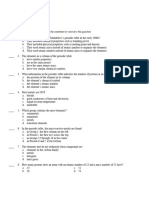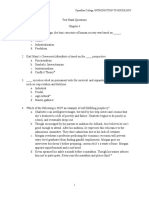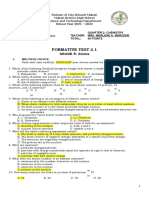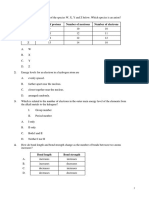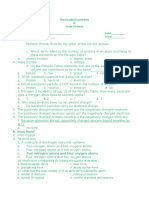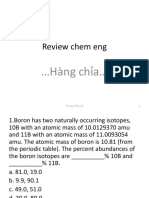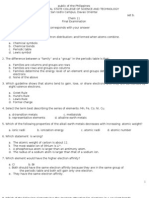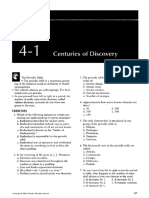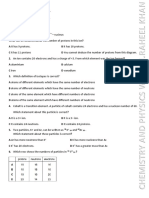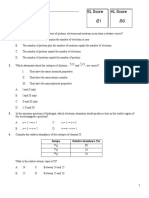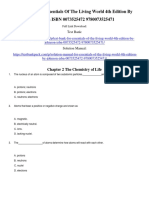Chapter 2-Atoms and Molecules: The Chemical Basis of Life: Multiple Choice
Chapter 2-Atoms and Molecules: The Chemical Basis of Life: Multiple Choice
Uploaded by
Razane AbouzaidCopyright:
Available Formats
Chapter 2-Atoms and Molecules: The Chemical Basis of Life: Multiple Choice
Chapter 2-Atoms and Molecules: The Chemical Basis of Life: Multiple Choice
Uploaded by
Razane AbouzaidOriginal Title
Copyright
Available Formats
Share this document
Did you find this document useful?
Is this content inappropriate?
Copyright:
Available Formats
Chapter 2-Atoms and Molecules: The Chemical Basis of Life: Multiple Choice
Chapter 2-Atoms and Molecules: The Chemical Basis of Life: Multiple Choice
Uploaded by
Razane AbouzaidCopyright:
Available Formats
Chapter 2—Atoms and Molecules: The Chemical Basis of Life
MULTIPLE CHOICE
1. An organic compound differs from an inorganic compound in that an organic compound:
a. contains carbon.
b. contains two or more atoms.
c. lacks valence electrons.
d. lacks isotopes.
e. is basic rather than acidic.
ANS: A PTS: 1 REF: p. 27 OBJ: Bloom's: Comprehension
2. An element is defined as a substance that:
a. is composed of more than one kind of atom.
b. is held together by covalent bonds.
c. cannot be broken into simpler substances by chemical reactions.
d. cannot burn.
e. is soluble in both acid and base.
ANS: C PTS: 1 REF: p. 27 OBJ: Bloom's: Knowledge
3. Which of the following elements is NOT responsible for a significant portion of the mass of living
organisms?
a. O
b. S
c. N
d. H
e. C
ANS: B PTS: 1 REF: p. 27 OBJ: Bloom's: Comprehension
4. The particular type of element is determined by the number of:
a. electrons
b. protons
c. neutrons
d. valence electrons
e. energy levels
ANS: B PTS: 1 REF: p. 27 OBJ: Bloom's: Knowledge
5. If atom X contains 14 protons, 13 electrons, and 12 neutrons, and atom Y contains 14 protons, 14
electrons, and 12 neutrons, then you conclude that:
a. Y is an ion but X is not.
b. X and Y are both ions.
c. X and Y both have filled valence shells.
d. X and Y are isotopes of the same element.
e. X and Y are atoms of the same element.
ANS: E PTS: 1 REF: p. 27 OBJ: Bloom's: Application
Chapter 2—Atoms and Molecules: The Chemical Basis of Life 16
6. An atom has six protons and eight neutrons. Its atomic mass is __________ atomic mass units.
a. two
b. four
c. six
d. eight
e. fourteen
ANS: E PTS: 1 REF: p. 29 OBJ: Bloom's: Comprehension
7. The difference between a stable isotope and a radioisotope is that:
a. the stable isotope emits radiation.
b. the radioisotope emits radiation.
c. the stable isotope emits light.
d. the stable isotope absorbs radiation.
e. the radioisotope has an unequal number of protons and electrons.
ANS: B PTS: 1 REF: p. 29 OBJ: Bloom's: Comprehension
Figure 2-1
Use the figure below to answer the corresponding question(s).
8. The atomic mass of the atom identified as A in Figure 2-1 is:
a. 2.
b. 6.
c. 8.
d. 12.
e. 18.
ANS: D PTS: 1 REF: p. 29 OBJ: Bloom's: Application
9. Figure 2-1 represents:
a. two isotopes of the same element.
b. two different elements.
c. two different ions.
d. an acid and a base.
e. a cation and an anion.
ANS: A PTS: 1 REF: p. 29 OBJ: Bloom's: Application
10. The difference between the two atoms in Figure 2-1 is:
a. pH.
b. the number of electrons.
c. the number of protons.
d. the number of neutrons.
e. electrical charge.
ANS: D PTS: 1 REF: p. 29 OBJ: Bloom's: Application
Chapter 2—Atoms and Molecules: The Chemical Basis of Life 17
11. Isotopes differ from each other with respect to the number of:
a. protons only.
b. electrons only.
c. neutrons only.
d. both protons and electrons.
e. both neutrons and protons.
ANS: C PTS: 1 REF: p. 29 OBJ: Bloom's: Knowledge
12. Radioisotopes are used in all of the following scientific applications except:
a. dating fossils.
b. determining the sequence of genetic information in DNA.
c. localization of a drug, such as marijuana.
d. the treatment of cancer.
e. measuring the pH of the blood.
ANS: E PTS: 1 REF: p. 29-30 OBJ: Bloom's: Comprehension
13. The chemical behavior of an atom is determined by most directly by the:
a. atomic number.
b. atomic weight.
c. number of energy levels.
d. number of valence electrons.
e. number of neutrons.
ANS: D PTS: 1 REF: p. 31 OBJ: Bloom's: Comprehension
14. Which of the following statements is FALSE?
a. The 1st principal energy level contains 1 orbital.
b. The 2nd principal energy level contains 4 orbitals.
c. The 1st principal energy level contains a maximum of 2 electrons.
d. The 2nd energy level contains a maximum of 10 electrons.
e. The 2nd energy level contains 1 spherical orbital and 3 dumbbell-shaped orbitals..
ANS: D PTS: 1 REF: p. 30 OBJ: Bloom's: Comprehension
15. Chlorine has seven electrons in its valence shell. The number of electrons it must gain to complete its
valence shell is:
a. one.
b. two.
c. three.
d. seven.
e. eight.
ANS: A PTS: 1 REF: p. 31 OBJ: Bloom's: Application
16. Any chemical interaction between atoms:
a. involves neutrons.
b. may potentially involve any electron.
c. involves protons.
d. involves only valence electrons.
e. involves only the nuclear subatomic particles.
ANS: D PTS: 1 REF: p. 31 OBJ: Bloom's: Comprehension
Chapter 2—Atoms and Molecules: The Chemical Basis of Life 18
17. The representation HOH is known as:
a. a structural formula.
b. a simplest formula.
c. a molecular formula.
d. a Lewis structure.
e. an orbital diagram.
ANS: A PTS: 1 REF: p. 31 OBJ: Bloom's: Knowledge
18. The molecular mass of C6H12O6 is 180 amu. 0.25 moles of this substance contain:
a. 180 daltons.
b. 45 g.
c. 1.8 g.
d. 45 daltons.
e. 180 g.
ANS: B PTS: 1 REF: p. 31-32 OBJ: Bloom's: Application
19. How many molecules are present in one mole of C 6H12O6?
a. 1.7 1010 molecules
b. 1.3 1010 molecules
c. 24 molecules
d. 1.7 1022 molecules
e. 6.02 1023 molecules
ANS: E PTS: 1 REF: p. 32 OBJ: Bloom's: Comprehension
20. Which of the following choices correctly identifies a reactant in the following chemical equation?
3
CO2 + H2O H2CO
a. carbonic acid
b. oxygen
c. water
d. sugar
e. carbon monoxide
ANS: C PTS: 1 REF: p. 32 OBJ: Bloom's: Comprehension
21. In a chemical reaction, the product is:
a. generally written on the right side of the equation.
b. always in equilibrium with the reactants.
c. the substance that is generated by the reaction.
d. joined by an ionic bond only.
e. generally written on the right side and is the substance generated by the reaction.
ANS: E PTS: 1 REF: p. 32 OBJ: Bloom's: Comprehension
22. When a chemical reaction is at equilibrium:
a. the forward reaction is going faster.
b. the reverse reaction is going faster.
c. the forward and reverse reactions are proceeding at equal rates.
d. the forward reaction stops.
e. the reverse reaction stops.
ANS: C PTS: 1 REF: p. 32 OBJ: Bloom's: Knowledge
Chapter 2—Atoms and Molecules: The Chemical Basis of Life 19
Figure 2-2
Use the figure below to answer the corresponding question(s).
23. Figure 2-2 represents:
a. elemental helium.
b. molecular hydrogen.
c. molecular helium.
d. a water molecule.
e. molecular oxygen.
ANS: B PTS: 1 REF: p. 33 OBJ: Bloom's: Comprehension
24. The type of bond illustrated in Figure 2-2 is:
a. an ionic bond.
b. a polar bond.
c. a single covalent bond.
d. a hydrogen bond.
e. a double covalent bond.
ANS: C PTS: 1 REF: p. 33 OBJ: Bloom's: Comprehension
25. Which covalent bond involves only 2 electrons:
a. single
b. double
c. triple
d. single and double.
e. single and triple.
ANS: A PTS: 1 REF: p. 33 OBJ: Bloom's: Knowledge
26. A covalent bond:
a. forms only between identical atoms.
b. involves a sharing of only one pair of electrons.
c. is always polar.
d. may be polar or nonpolar depending on the atoms involved.
e. always forms between identical molecules.
ANS: D PTS: 1 REF: p. 33-34 OBJ: Bloom's: Comprehension
27. In a water molecule, because oxygen is more electronegative than hydrogen, the shared electrons are
more commonly found around the __________ nucleus than the __________ nucleus.
a. oxygen; hydrogen
b. hydrogen; oxygen
c. hydrogen; other hydrogen
d. oxygen; nitrogen
e. nitrogen; oxygen
ANS: A PTS: 1 REF: p. 34 OBJ: Bloom's: Comprehension
Chapter 2—Atoms and Molecules: The Chemical Basis of Life 20
28. The covalent bond between a hydrogen atom and the oxygen atom in water is formed when:
a. hydrogen gains an electron from oxygen.
b. hydrogen and oxygen share an electron pair.
c. hydrogen and oxygen both lose electrons from their outer shells.
d. hydrogen and oxygen both gain electrons in their outer shells.
e. hydrogen gains an electron from oxygen.
ANS: B PTS: 1 REF: p. 34 OBJ: Bloom's: Comprehension
29. Covalently bonded atoms with similar electronic negativities are:
a. ionic.
b. polar.
c. nonpolar.
d. partially positive.
e. partially negative.
ANS: C PTS: 1 REF: p. 34 OBJ: Bloom's: Comprehension
30. An atom becomes a cation if:
a. it gains one or more electron.
b. it loses one or more electron.
c. it shares electrons.
d. one or more of its electrons changes energy levels.
e. it emits radiation.
ANS: B PTS: 1 REF: p. 34 OBJ: Bloom's: Application
31. The difference between an electrically neutral atom and an ion is that:
a. an ion has an unequal number of protons and electrons, while an atom has an equal
number.
b. an ion has an equal number of protons and electrons, while an atom has an unequal
number.
c. an atom has an unequal number of neutrons and protons, while an ion has an equal
number.
d. an atom has its electrons in orbitals, while an ion has its electrons in its nucleus.
e. an atom must have an equal number of neutrons and electrons, while an ion does not.
ANS: A PTS: 1 REF: p. 34 OBJ: Bloom's: Comprehension
32. In the formation of common table salt, sodium and chlorine interact because:
a. sodium and chlorine share a pair of electrons.
b. sodium and chlorine share two pairs of electrons.
c. chlorine donates seven electrons to sodium.
d. there is no electron exchange.
e. sodium donates one electron to chlorine.
ANS: E PTS: 1 REF: p. 35 OBJ: Bloom's: Comprehension
Chapter 2—Atoms and Molecules: The Chemical Basis of Life 21
33. Table salt dissolves easily in water because:
a. water can form covalent linkages with salt molecules.
b. water can remove electrons from the chloride ion, which causes the latter to dissociate
from the sodium and dissolve.
c. water can add electrons to the sodium ion.
d. water is polar and salt is nonpolar. Nonpolar compounds are more soluble in polar
solvents because they are able to form strong covalent bonds that result in a breaking up of
the molecule being dissolved.
e. the partial positive charge of the hydrogens in the water molecule can associate with the
negative charge of the chloride ion, and the partial negative charge of the oxygen of the
water molecule can associate with the positive charge of the sodium atom.
ANS: E PTS: 1 REF: p. 36 OBJ: Bloom's: Comprehension
34. Which of the following atoms would most likely be involved in an ionic bond?
a. hydrogen
b. oxygen
c. sodium
d. hydrogen and oxygen.
e. hydrogen and sodium.
ANS: C PTS: 1 REF: p. 35 OBJ: Bloom's: Comprehension
35. The process whereby water molecules surround ions during the process of dissolving is called:
a. reduction.
b. hydration.
c. buffering.
d. oxidation.
e. vaporization.
ANS: B PTS: 1 REF: p. 36 OBJ: Bloom's: Knowledge
36. Which of the following statements concerning van der Waal interactions is FALSE:
a. They are attractive forces.
b. They are very strong.
c. They involve transient regions of positive and negative charges.
d. They form between nonpolar molecules.
e. They operate over very short distances.
ANS: B PTS: 1 REF: p. 36 OBJ: Bloom's: Knowledge
37. Which component becomes oxidized in the following chemical reaction?
3
4 Fe + 3 O2 2 Fe2O
a. water
b. iron
c. oxygen
d. rust
e. hydrogen
ANS: B PTS: 1 REF: p. 37 OBJ: Bloom's: Application
Chapter 2—Atoms and Molecules: The Chemical Basis of Life 22
38. Which component is the oxidizing agent in the following chemical reaction?
3
4 Fe + 3 O2 2 Fe2O
a. water
b. iron
c. oxygen
d. rust
e. hydrogen
ANS: C PTS: 1 REF: p. 37 OBJ: Bloom's: Application
39. The cohesiveness between water molecules is due largely to:
a. hydrogen bonds.
b. polar covalent bonds.
c. nonpolar covalent bonds.
d. ionic bonds.
e. hydrophobic interactions.
ANS: A PTS: 1 REF: p. 38 OBJ: Bloom's: Knowledge
40. A stalk of celery is placed in a solution of blue colored dye. After one hour, the leaves have blue fluid
in their veins. Which property of water is being demonstrated?
a. adhesion and cohesion
b. evaporation and cooling
c. lower density as a solid than as a liquid
d. high specific heat
e. surface tension
ANS: A PTS: 1 REF: p. 38 OBJ: Bloom's: Application
41. Which characteristic of water molecules directly contributes to the remarkable "water walking"
success of the aquatic insects pictured in the accompanying figure?
a. hydrogen bonds
b. capillary action
c. nonpolar covalent bonds
d. ionic bonds
e. adhesive forces
ANS: A PTS: 1 REF: p. 38 OBJ: Bloom's: Comprehension
42. Which of the following statements is not correct?
a. Water heats up and cools down very quickly.
b. The amount of heat required to raise the temperature of 1 g of water 1 C is one calorie.
c. Due to hydrogen bonds, water has a high surface tension.
d. Large bodies of water have relatively constant temperatures.
e. When one gram of water evaporates, it removes heat.
ANS: A PTS: 1 REF: p. 38-40 OBJ: Bloom's: Comprehension
Chapter 2—Atoms and Molecules: The Chemical Basis of Life 23
43. It takes 1 calorie of heat to raise the temperature of 1 gram of water 1 degree Celsius at sea level. This
is referred to as the __________ of water.
a. heat of fusion
b. heat of vaporization
c. specific heat
d. heat of transformation
e. heat of homeostasis
ANS: C PTS: 1 REF: p. 40 OBJ: Bloom's: Knowledge
44. Which property of water enables living things to survive in ponds covered with ice?
a. high heat of vaporization
b. high specific heat
c. degree of surface tension
d. cohesion
e. greatest density at 4oC
ANS: E PTS: 1 REF: p. 40 OBJ: Bloom's: Comprehension
45. Evaporative cooling is a process whereby __________ moving __________ molecules vaporize, thus
__________ large amounts of heat.
a. slow; water; adding
b. fast; water; removing
c. slow; oxygen; adding
d. fast; oxygen; removing
e. fast; carbon dioxide; removing
ANS: B PTS: 1 REF: p. 40 OBJ: Bloom's: Comprehension
46. At what temperature is water most dense?
a. 0 degrees Celsius
b. 1 degree Celsius
c. 4 degrees Celsius
d. 10 degrees Celsius
e. 100 degrees Celsius
ANS: C PTS: 1 REF: p. 40 OBJ: Bloom's: Knowledge
47. In a mixture, which would be present in the least amount?
a. solvent
b. solute
c. water
d. both solvent and solute
e. both solvent and water
ANS: B PTS: 1 REF: p. 36 OBJ: Bloom's: Knowledge
Chapter 2—Atoms and Molecules: The Chemical Basis of Life 24
48. This characteristic of a molecule determines the ability of hydrogen bonds to form between it and
hydrogen:
a. A nonpolar atom.
b. An atom with a partial positive charge.
c. An atom with a partial negative charge.
d. A hydrophobic molecule.
e. An atom with a filled valence shell.
ANS: C PTS: 1 REF: p. 36 OBJ: Bloom's: Comprehension
49. Which characteristic of water makes the existence of pH possible?
a. ionization
b. polarity
c. adhesion
d. cohesion
e. hydrophobicity
ANS: A PTS: 1 REF: p. 40 OBJ: Bloom's: Comprehension
50. A pH of 4 is __________ times more __________ than a pH of 7.
a. 3; basic
b. 3; acidic
c. 1000; neutral
d. 1000; basic
e. 1000; acidic
ANS: E PTS: 1 REF: p. 41 OBJ: Bloom's: Application
51. What is the OH concentration of a solution having a pH of 2?
a. 1 1012
b. 1 1010
c. 1 107
d. 1 102
e. 1 101
ANS: A PTS: 1 REF: p. 41 OBJ: Bloom's: Application
52. When a small amount of hydrochloric acid (HCl) is added to a solution of Na 2HPO4, the pH of the
solution does not change markedly. The pH also does not change drastically when a small amount of
sodium hydroxide (NaOH) is added to this same solution. Based on these observations, the compound
Na2HPO4 is:
a. able to donate hydrogen atoms to HCl.
b. able to remove hydrogen ions from the OH of NaOH.
c. acting as a buffer.
d. an enzyme facilitating the reaction between HCl and NaOH.
e. acting as a solvent.
ANS: C PTS: 1 REF: p. 42 OBJ: Bloom's: Application
Chapter 2—Atoms and Molecules: The Chemical Basis of Life 25
53. A salt is a compound in which the hydrogen ion of __________ is replaced by some other cation.
a. a base
b. an acid
c. an anion
d. a hydroxide ion
e. water
ANS: B PTS: 1 REF: p. 42 OBJ: Bloom's: Knowledge
54. A solution having a pH of 6 would:
a. have equal concentrations of hydrogen ions and hydroxide ions.
b. have a higher concentrations of hydroxide ions than hydrogen ions.
c. be slightly acidic.
d. be slightly basic.
e. be neutral.
ANS: C PTS: 1 REF: p. 41 OBJ: Bloom's: Knowledge
55. Identify the chemical(s) that act(s) as a buffer in human blood:
a. bicarbonate
b. hydrogen ions
c. carbon dioxide
d. water
e. hydroxide ions
ANS: A PTS: 1 REF: p. 42 OBJ: Bloom's: Knowledge
56. Identify the hydrogen ion concentration that represents the lowest pH from the following list:
a. 1 103
b. 1 104
c. 1 107
d. 1 1011
e. 1 1014
ANS: A PTS: 1 REF: p. 41 OBJ: Bloom's: Knowledge
57. Which of the following has a pH closest to that of human blood?
a. beer
b. coffee
c. rain water
d. sea water
e. oven cleaner
ANS: D PTS: 1 REF: p. 41 OBJ: Bloom's: Knowledge
58. Which of the following would most likely form electrolytes in water?
a. glucose
b. ethanol
c. an organic compound
d. an inorganic compound
e. a nonionic compound
ANS: D PTS: 1 REF: p. 42 OBJ: Bloom's: Knowledge
Chapter 2—Atoms and Molecules: The Chemical Basis of Life 26
SHORT ANSWER
1. List the four elements that account for over 90% of the mass of living organisms and identify an
important biological function of each element.
ANS:
Some examples from Table 2-1: Oxygen is required for cellular respiration, carbon forms the
backbone of organic molecules, hydrogen is involved in some energy transfers, and nitrogen is a
component of proteins and nucleic acids.
PTS: 1 REF: p. 27 OBJ: Bloom's: Knowledge
2. Explain how the number of valence electrons is related to the chemical properties of an atom. Use two
specific examples in your explanation.
ANS:
Atoms having filled valence shells (e.g., helium and neon) are stable and unreactive; atoms having
unfilled valence shells (e.g., chlorine and sodium) are unstable and reactive.
PTS: 1 REF: p. 31 OBJ: Bloom's: Comprehension
3. Compare and contrast the formation, properties, and characteristics of covalent and ionic bonds.
ANS:
Both covalent and ionic bonds result in each atom having a filled valence shell. Covalent bonds are
formed via the sharing of electrons between neutral atoms; the resulting molecule is electrically
neutral but can be polar or nonpolar. Ionic bonds are formed via the transfer of electrons; in the
process ions are formed, and the resulting molecule is held together via the electrical attraction
between those positive and negative ions. Unlike atoms joined by a covalent bond, atoms joined by an
ionic bond tend to dissociate into their respective ions when placed in water.
PTS: 1 REF: p. 34-35 OBJ: Bloom's: Analysis
4. Diagram and carefully label two water molecules using a ball-and-stick model. Then use this diagram
to demonstrate how hydrogen bonds form between them.
ANS:
The diagram should resemble Fig. 2-13 except only two water molecules are shown. Hydrogen bonds
form as a result of the attraction between the partial positive charge of a hydrogen atom with the
partial negative charge of the oxygen atom
PTS: 1 REF: p. 38 OBJ: Bloom's: Analysis
MODIFIED TRUE/FALSE
1. An inorganic compound is one that contains carbon.
__________________
ANS: F, organic
PTS: 1 REF: p. 27 OBJ: Bloom's: Knowledge
Chapter 2—Atoms and Molecules: The Chemical Basis of Life 27
2. The atomic mass determines the type of element.
__________________
ANS: F, number
PTS: 1 REF: p. 28 OBJ: Bloom's: Knowledge
3. An atom having a filled valence shell is stable and unreactive.
__________________
ANS: T PTS: 1 REF: p. 31
OBJ: Bloom's: Knowledge
4. When atoms react to form an ionic bond, electrons are shared between those atoms.
__________________
ANS: F, transferred
PTS: 1 REF: p. 35 OBJ: Bloom's: Knowledge
5. The tetrahedron shape of a methane molecule is the result of orbital hybridization.
__________________
ANS: T PTS: 1 REF: p. 34
OBJ: Bloom's: Knowledge
6. An example of an anion is K+.
__________________
ANS: F, a cation
PTS: 1 REF: p. 34 OBJ: Bloom's: Knowledge
7. Oxidation occurs when an atom gains one or more electrons.
__________________
ANS: F, loses
PTS: 1 REF: p. 37 OBJ: Bloom's: Knowledge
8. Specific heat refers to the amount of energy required to change 1 gram of a substance from the liquid
phase to the vapor phase.
__________________
ANS: F, Heat of vaporization
PTS: 1 REF: p. 39 OBJ: Bloom's: Knowledge
9. Water is most dense at 4 C.
__________________
ANS: T PTS: 1 REF: p. 40
OBJ: Bloom's: Knowledge
Chapter 2—Atoms and Molecules: The Chemical Basis of Life 28
10. A solution having a pH of 8 is slightly acidic.
__________________
ANS: F, basic
PTS: 1 REF: p. 41 OBJ: Bloom's: Knowledge
11. A substance that is resistant to changes in pH is called a buffer.
__________________
ANS: T PTS: 1 REF: p. 42
NOT: Bloom's: Knowledge
MATCHING
Match the type of bond or interaction with its description.
a. hydrogen bond c. ionic bond
b. van de Waals interaction d. covalent bond
1. Strong attractive force resulting from the transfer of electrons between atoms
2. Strong attractive force resulting from the sharing of electrons between atoms
3. Weak attractive force joining a hydrogen atom with an electronegative atom such as oxygen
4. In a structural formula this is represented by a straight line
5. Very weak attractive force joining nonpolar molecules
6. Holds adjacent water molecules together
1. ANS: C PTS: 1 REF: p. 35 OBJ: Bloom's: Knowledge
2. ANS: D PTS: 1 REF: p. 32 OBJ: Bloom's: Knowledge
3. ANS: A PTS: 1 REF: p. 36 OBJ: Bloom's: Knowledge
4. ANS: D PTS: 1 REF: p. 33 OBJ: Bloom's: Knowledge
5. ANS: B PTS: 1 REF: p. 36 OBJ: Bloom's: Knowledge
6. ANS: A PTS: 1 REF: p. 37 OBJ: Bloom's: Comprehension
Match the term with its description.
a. adhesion c. surface tension
b. cohesion d. capillary action
7. Sticking together of like molecules
8. Directly responsible for the ability of certain insects to walk on water
9. Responsible for the ability of water molecules to move in the microscopic spaces between soil
particles
10. Sticking together of unlike molecules
11. Tendency of water to move in narrow tubes
7. ANS: B PTS: 1 REF: p. 38 OBJ: Bloom's: Knowledge
8. ANS: C PTS: 1 REF: p. 38 OBJ: Bloom's: Knowledge
9. ANS: D PTS: 1 REF: p. 38 OBJ: Bloom's: Knowledge
10. ANS: A PTS: 1 REF: p. 38 OBJ: Bloom's: Knowledge
11. ANS: D PTS: 1 REF: p. 38 OBJ: Bloom's: Knowledge
Chapter 2—Atoms and Molecules: The Chemical Basis of Life 29
ESSAY
1. As a researcher, you are charged with determining the side effects of a new drug. From previous
observations, you suspect that this drug reduces the rate of DNA production (replication) within skin
cells of patients using the drug. With the following materials, design an experiment that would answer
your questions about the effect of the drug on DNA production. You know that: DNA contains
phosphate groups. You have: radioactive isotopes of phosphate (32P), skin cell cultures from various
patients, the drug in question, and a device that measures radioactivity.
ANS:
Concepts to Consider: Construction of an appropriate experiment with appropriate controls; use of
the radioisotope to label DNA; isolation of the DNA using an unspecified technique; measuring
radioactivity of the isolated DNA; comparing the treatment and control groups; making a conclusion.
PTS: 1 REF: p. 29 OBJ: Bloom's: Synthesis
TOP: Discussion or Thought Questions
2. The hydrogen bonds of water play an important role in the ability of animals to regulate their body
temperature. Explain how this occurs.
ANS:
Concepts to Consider: Transfer of energy to the hydrogen bonds; excess body heat is transferred to
hydrogen bonds of water; heat is removed when water vaporizes at the body surface of the animal.
PTS: 1 REF: p. 40 OBJ: Bloom's: Comprehension
TOP: Discussion or Thought Questions
3. Explain the role of carbon dioxide in maintaining blood pH levels.
ANS:
Concepts to Consider: Buffering capacity; reversible reactions; maintenance of equilibrium.
PTS: 1 REF: p. 42 OBJ: Bloom's: Comprehension
TOP: Discussion or Thought Questions
Chapter 2—Atoms and Molecules: The Chemical Basis of Life 30
You might also like
- Life The Science of Biology 11th Edition Sadava Hillis Heller Hacker Test BankDocument90 pagesLife The Science of Biology 11th Edition Sadava Hillis Heller Hacker Test Banknick100% (33)
- Periodic Table Practice TestDocument4 pagesPeriodic Table Practice TestKattia MartinezNo ratings yet
- Test Bank Chapter 4Document5 pagesTest Bank Chapter 4Razane AbouzaidNo ratings yet
- Bushong: Radiologic Science For Technologists, 9th Edition: Chapter 3: The Structure of Matter Test Bank Multiple ChoiceDocument7 pagesBushong: Radiologic Science For Technologists, 9th Edition: Chapter 3: The Structure of Matter Test Bank Multiple ChoicePring FamNo ratings yet
- Formative Test 2.1: GRADE 8: AtomsDocument4 pagesFormative Test 2.1: GRADE 8: AtomsKeisha Gabrielle RabanoNo ratings yet
- IB HL Chemistry Atomic Structure QuestionsDocument20 pagesIB HL Chemistry Atomic Structure Questionshaseabamin100% (3)
- Test Bank Chapter 3Document5 pagesTest Bank Chapter 3Razane AbouzaidNo ratings yet
- Test Bank Chapter 15Document5 pagesTest Bank Chapter 15Razane Abouzaid100% (1)
- Test Bank Chapter 11Document5 pagesTest Bank Chapter 11Razane AbouzaidNo ratings yet
- Test Bank Chapter 3Document5 pagesTest Bank Chapter 3Razane AbouzaidNo ratings yet
- Test Bank Chapter 15Document5 pagesTest Bank Chapter 15Razane Abouzaid100% (1)
- Test Bank Chapter 1Document5 pagesTest Bank Chapter 1Razane Abouzaid100% (1)
- Biochemistry Unit Practice TestDocument13 pagesBiochemistry Unit Practice Testronaldo8100% (1)
- Starr 02 - 03Document18 pagesStarr 02 - 03John EspiqueNo ratings yet
- Introduction To Chemistry 3rd Edition Bauer Birk Marks Test BankDocument22 pagesIntroduction To Chemistry 3rd Edition Bauer Birk Marks Test Bankcasey100% (38)
- Third Grading Examination in Grade 9 Science Name: - Date: - Section: - ScoreDocument4 pagesThird Grading Examination in Grade 9 Science Name: - Date: - Section: - ScoreSharonNo ratings yet
- Review Chem Eng MidDocument32 pagesReview Chem Eng MidTrân LêNo ratings yet
- STRUCTURE-1 WorksheetDocument77 pagesSTRUCTURE-1 Worksheetnada.radwan01No ratings yet
- Chapter 3-The Chemistry of Life: Organic Compounds: Multiple ChoiceDocument18 pagesChapter 3-The Chemistry of Life: Organic Compounds: Multiple ChoiceRazane AbouzaidNo ratings yet
- General Chemistry 10th Edition by Ebbing Gammon ISBN Test BankDocument63 pagesGeneral Chemistry 10th Edition by Ebbing Gammon ISBN Test Bankmichael98% (42)
- Basic Chemistry Review Packet Key EL 15-16Document6 pagesBasic Chemistry Review Packet Key EL 15-16Shayla MaysNo ratings yet
- Chapter 2 - Chemistry of Life: Multiple ChoiceDocument9 pagesChapter 2 - Chemistry of Life: Multiple ChoiceMike Murdock100% (1)
- 8 Science 3rd & 4th Quarter Exam - FinalDocument6 pages8 Science 3rd & 4th Quarter Exam - FinalAbe Estrada EnanoNo ratings yet
- Department of Education: Grade 9-Science S.Y. 2019-2020Document5 pagesDepartment of Education: Grade 9-Science S.Y. 2019-2020norbertNo ratings yet
- CHEM2 Chemistry in Your World 2nd Edition by Hogg - Test BankDocument79 pagesCHEM2 Chemistry in Your World 2nd Edition by Hogg - Test BanksegnuzolmaNo ratings yet
- Sci-9 2nd Grading ExamDocument14 pagesSci-9 2nd Grading ExamIAN TAPIANo ratings yet
- At Keeansa Work Sheetgrade 11 Unit 2 WPS OfficeDocument3 pagesAt Keeansa Work Sheetgrade 11 Unit 2 WPS Officenesrujemal328No ratings yet
- SafariDocument11 pagesSafaricynkgwfnqvNo ratings yet
- Summative Test For Finals Gen Chem 1Document9 pagesSummative Test For Finals Gen Chem 1Rebecca DumlaoNo ratings yet
- Test Bank For Introduction To Chemistry 3rd Edition Bauer Birk Marks 0073402672 9780073402673Document36 pagesTest Bank For Introduction To Chemistry 3rd Edition Bauer Birk Marks 0073402672 9780073402673CharlesLarsonsxag100% (31)
- Atomic Structure and The Periodic TableDocument3 pagesAtomic Structure and The Periodic TableKhoer Ummah100% (1)
- Introduction To Chemistry 4th Edition Bauer Birk Marks Test BankDocument52 pagesIntroduction To Chemistry 4th Edition Bauer Birk Marks Test Bankcasey100% (37)
- PrELIM EXAM CHEMISTRYDocument9 pagesPrELIM EXAM CHEMISTRYrudycamay100% (2)
- Physical ScienceDocument3 pagesPhysical ScienceJemimah Corporal100% (1)
- Worksheet AnswerchemoDocument15 pagesWorksheet Answerchemodaghawi910No ratings yet
- SCH3U Chemistry Unit 1 MC ReviewDocument16 pagesSCH3U Chemistry Unit 1 MC Review1moeezafNo ratings yet
- Estructura AtomicaDocument12 pagesEstructura AtomicaYassica Yiriath Pandales CastilloNo ratings yet
- 3rd Quarter Examination Science 8Document6 pages3rd Quarter Examination Science 8Lani Bernardo CuadraNo ratings yet
- What Can Be Deduced About The Number of Protons in This Ion?Document8 pagesWhat Can Be Deduced About The Number of Protons in This Ion?HashimNo ratings yet
- 2016 CHEM W. SHEET-IDocument8 pages2016 CHEM W. SHEET-IGemeda MeskeluNo ratings yet
- 2nd Mastery Test ChemistryDocument3 pages2nd Mastery Test Chemistrystephenibahan330No ratings yet
- Grade 9 Q2 Study TestDocument46 pagesGrade 9 Q2 Study TestShanna Sophia PelicanoNo ratings yet
- Second PTDocument2 pagesSecond PTErlin Panganiban AguilaNo ratings yet
- Third Periodical Test Science 8Document3 pagesThird Periodical Test Science 8Armilyn AbrisNo ratings yet
- Periodic Test in Chemistry-Grade 9Document4 pagesPeriodic Test in Chemistry-Grade 9Lourdes CalisuraNo ratings yet
- G-9 Chem .Second Sem Final 2016 Last EditedDocument6 pagesG-9 Chem .Second Sem Final 2016 Last Editedtesfayee779No ratings yet
- 2 Atomic-Str QDocument20 pages2 Atomic-Str QanjaliNo ratings yet
- Third Periodical Test Science 8Document3 pagesThird Periodical Test Science 8Sheik Lucky AcostaNo ratings yet
- Practicetopic 2 Paper 1Document7 pagesPracticetopic 2 Paper 1MICHAEL ETHAN U. YUNo ratings yet
- 2nd-Unit TestDocument2 pages2nd-Unit TestCedric Tamares Evaristo100% (1)
- Chapter 2 Atoms, MoleculesDocument27 pagesChapter 2 Atoms, Moleculesanonymous0% (1)
- CH 2 Test Bank For Essential Cell Biology 3rd Edition AlbertsDocument16 pagesCH 2 Test Bank For Essential Cell Biology 3rd Edition AlbertsRokia GhariebNo ratings yet
- Diagnostic Science9Document3 pagesDiagnostic Science9Mantikar Ismael50% (2)
- Section - 2 Microscopic WorldDocument45 pagesSection - 2 Microscopic World(4C27) Wong Ching Tung, Zoey 20181D043spss.hkNo ratings yet
- Quiz - Bonding A KEYDocument3 pagesQuiz - Bonding A KEYManongdo Allan100% (1)
- Test Bank For Principles of General Organic and Biological Chemistry 2nd Edition Smith 0073511196 9780073511191Document36 pagesTest Bank For Principles of General Organic and Biological Chemistry 2nd Edition Smith 0073511196 9780073511191andrewgutierrezxtycopqfrd100% (32)
- Periodical Exam in Physical ScienceDocument3 pagesPeriodical Exam in Physical Sciencejayson babaran100% (1)
- Pixl Independence:: Chemistry - Student Booklet Ks5Document19 pagesPixl Independence:: Chemistry - Student Booklet Ks5saadNo ratings yet
- Sample Exam 3Document5 pagesSample Exam 3Sonia FelixNo ratings yet
- Quiz - Bonding B KEYDocument3 pagesQuiz - Bonding B KEYRavin BoodhanNo ratings yet
- Essentials of The Living World 4th Edition by Johnson ISBN Test BankDocument22 pagesEssentials of The Living World 4th Edition by Johnson ISBN Test Bankpaul100% (33)
- Chem 2Document5 pagesChem 2Lanz ManaloNo ratings yet
- Practice Makes Perfect in Chemistry: Chemical Bonding with AnswersFrom EverandPractice Makes Perfect in Chemistry: Chemical Bonding with AnswersRating: 5 out of 5 stars5/5 (1)
- Practice Makes Perfect in Chemistry: Chemical BondingFrom EverandPractice Makes Perfect in Chemistry: Chemical BondingRating: 5 out of 5 stars5/5 (3)
- Test Bank Chapter 12Document6 pagesTest Bank Chapter 12Razane AbouzaidNo ratings yet
- 11 PsoriasisDocument69 pages11 PsoriasisRazane AbouzaidNo ratings yet
- Test Bank Chapter 13Document5 pagesTest Bank Chapter 13Razane AbouzaidNo ratings yet
- Test Bank Chapter 10Document5 pagesTest Bank Chapter 10Razane AbouzaidNo ratings yet
- Chapter 3-The Chemistry of Life: Organic Compounds: Multiple ChoiceDocument18 pagesChapter 3-The Chemistry of Life: Organic Compounds: Multiple ChoiceRazane AbouzaidNo ratings yet
- Test Bank Chapter 14Document6 pagesTest Bank Chapter 14Razane AbouzaidNo ratings yet
- Chapter 6-Cell Communication: Multiple ChoiceDocument13 pagesChapter 6-Cell Communication: Multiple ChoiceRazane AbouzaidNo ratings yet


